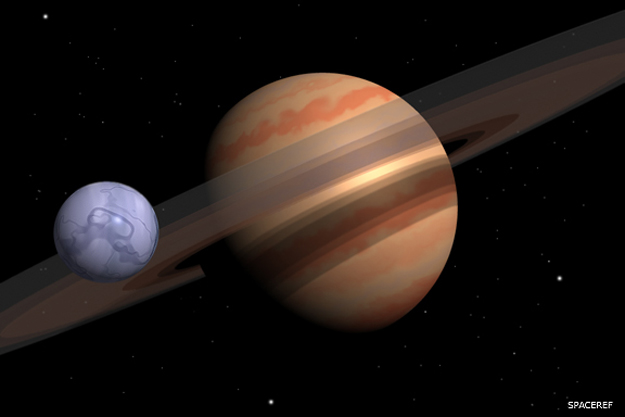As has been a consideration for some time, one of the frontier areas of astronomy especially in research in other solar systems is the search for moons of other planets, exomoons. British astronomer David Kipping has led the way in research that seems to support a very large exomoon around the exoplanet Kepler 1625 b. Kepler 1625 b is a super-Jupiter and its moon or exo-moon Kepler 1625 b i is a Neptune or sub-Neptune mass body. (Of course this moon would then be an order of magnitude more massive than Earth!) Of course this is where some of the dispute of this claim of discovery comes in as we don't have any moon anywhere near that mass in our solar system even around our planet Jupiter that barely has moons the mass of Earth's moon.
But if it is granted that there are exomoons, including the massive one around Kepler 1625 b (or possibly other similiarly massive ones around other super-Jupiters) my question is could or how likely would it be that these exomoons could themselves have moons or natural satellites? How gravitationally stable would the orbits of such moons of exomoons be including in different arrangements of planets, stars and moon masses or orbits or types of stars giant, dwarf or regular or temperature and spectral class? Also, it seems with our current technology clearly detecting moons of exomoons is very difficult. What would be the prospect of detecting sizable moons of large exomoons currently or in the forseeable future with transit, radial velocity, transit timing variation (TTV), direct imaging or other technologies including with the soon to be launched James Webb Space Telescope or fairly soon to have construction completed and go into science operations next generation larger ground based telescopes the Giant Magellan Telescope or the Extremely Large European Telescope?
But if it is granted that there are exomoons, including the massive one around Kepler 1625 b (or possibly other similiarly massive ones around other super-Jupiters) my question is could or how likely would it be that these exomoons could themselves have moons or natural satellites? How gravitationally stable would the orbits of such moons of exomoons be including in different arrangements of planets, stars and moon masses or orbits or types of stars giant, dwarf or regular or temperature and spectral class? Also, it seems with our current technology clearly detecting moons of exomoons is very difficult. What would be the prospect of detecting sizable moons of large exomoons currently or in the forseeable future with transit, radial velocity, transit timing variation (TTV), direct imaging or other technologies including with the soon to be launched James Webb Space Telescope or fairly soon to have construction completed and go into science operations next generation larger ground based telescopes the Giant Magellan Telescope or the Extremely Large European Telescope?



